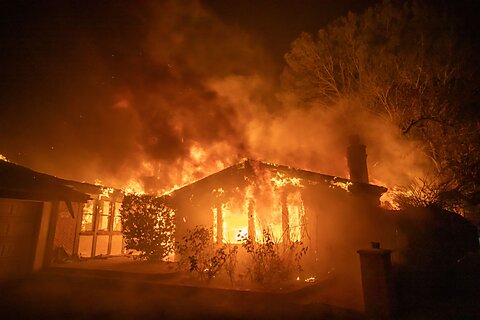Ryan Bourne and Sophia Bagley
California’s wildfire crisis isn’t just a natural disaster; it’s also a policy failure.
In recent years, state price control regulations have driven private home insurance providers like State Farm and Allstate out of offering new products in the state and led to the nonrenewal of thousands of existing home insurance policies. This has left many homeowners exposed to catastrophic financial losses from the recent wildfires and created a huge strain on the state-run Fair Access to Insurance Requirements (FAIR) plan, the insurer of last resort.
California’s price controls, whereby regulators must approve proposed premium increases, require insurers to submit detailed justifications for their rate increases to the California Department of Insurance (CDI). Crucially, those companies have until recently had to demonstrate that proposed premiums are based on historic losses, not analysis based on forward-looking risk assessments.
Designed to keep insurance premiums affordable, through rates that are never “excessive, inadequate, [or] unfairly discriminatory,” these regulations—introduced through Proposition 103—led to rules preventing companies from recalibrating prices to fully reflect what they believed were higher future wildfire risks after 2017.
The CDI rejected or delayed approval for substantial rate increases in many cases, creating a de facto price cap. Previous research from scholars at the International Center for Law and Economics shows that the average delay was 293 days between 2020 and 2022—a significant worsening from the average of 157 days between 2013 and 2019.
In fact, between 2017 and 2022, California was the worst state in the country for “rate suppression,” having the biggest gap between “the actuarially indicated rate and the rate approved by regulators.”
Firms weren’t just unable to reprice to reflect the new perceived risk of wildfires. California’s laws also limited insurers’ ability to reflect their own reinsurance costs into rates. Reinsurance, essential for shielding insurers from catastrophic events, has become increasingly expensive as wildfires grow more frequent and severe. Unable to pass these costs on to policyholders, insurers faced an untenable situation.
As detailed extensively in The War on Prices, prices aren’t just arbitrary numbers set by greedy corporations; they are signals that convey vital local knowledge and information. When an insurer raises premiums, it’s responding to both real-world data and its own expectations—about claims, rising reinsurance costs, high inflation, and worsening fire conditions.
Market prices thus serve as signals, telling homeowners, policymakers, and developers about the true costs of building and living in wildfire-prone areas. By capping insurance rates below what market conditions demanded, California muted these warning signals for some homeowners, forcing companies to price below expected cost and making consumers feel safer than they were. This encouraged development in fire-prone areas and reduced the incentive for homeowners to, say, purchase supplementary private fire insurance services.
But these capped prices have obvious detrimental consequences for other customers too. The result of holding prices below market rates saw insurers simply pull back from the highest-risk areas, where potential losses loomed large. State Farm, for example, announced plans to non-renew tens of thousands of policies in high-risk areas like Pacific Palisades, where 69 percent of properties were dropped. Millions of homeowners were thus forced into surplus lines insurers and onto the bare-bones FAIR plan (both of which, by the way, are allowed to use catastrophe models in setting their premiums). As a result, the FAIR plan’s exposure to losses statewide has ballooned to $458 billion, including an estimated $5.9 billion in Palisades alone and $24 billion in Los Angeles.
Tragically, tales are already filtering out about homes worth tens of millions of dollars not being insured at all. Not only will those families today face huge losses, but the FAIR plan itself is facing massive payouts. What if it can’t meet them all? Well, Politico reports that “it would draw from primary insurers to recoup its costs under state law, raising rates across all private policies and sending rates skyrocketing across the state.”
In other words, those who did get insurance in lower-risk areas will pay more to reflect the lack of insurance caused by price controls in high-risk areas.
California has belatedly recognized the problems its own rules are creating. That same Politico report details how, in recent weeks, the state’s insurance commissioner finalized rules that “gave insurance companies permission to pass along the costs of reinsurance to customers and use forward-looking so-called “catastrophic models” that take into account the likelihood of the type of climate-fueled fires raging in Los Angeles to raise rates.”
But even then the state cannot resist meddling. Those changes would come with a quid pro quo that “in exchange” insurers should meet “a certain quota of policies in disaster-prone areas.”
Will we never learn about the damage of price controls? Distorting market prices to lie about risk doesn’t make risk disappear. It simply leads people to make worse decisions and creates shortages of the product in question. California’s failed experiment in price controls has left homeowners paying the ultimate price in the face of an increasingly dangerous wildfire reality.

